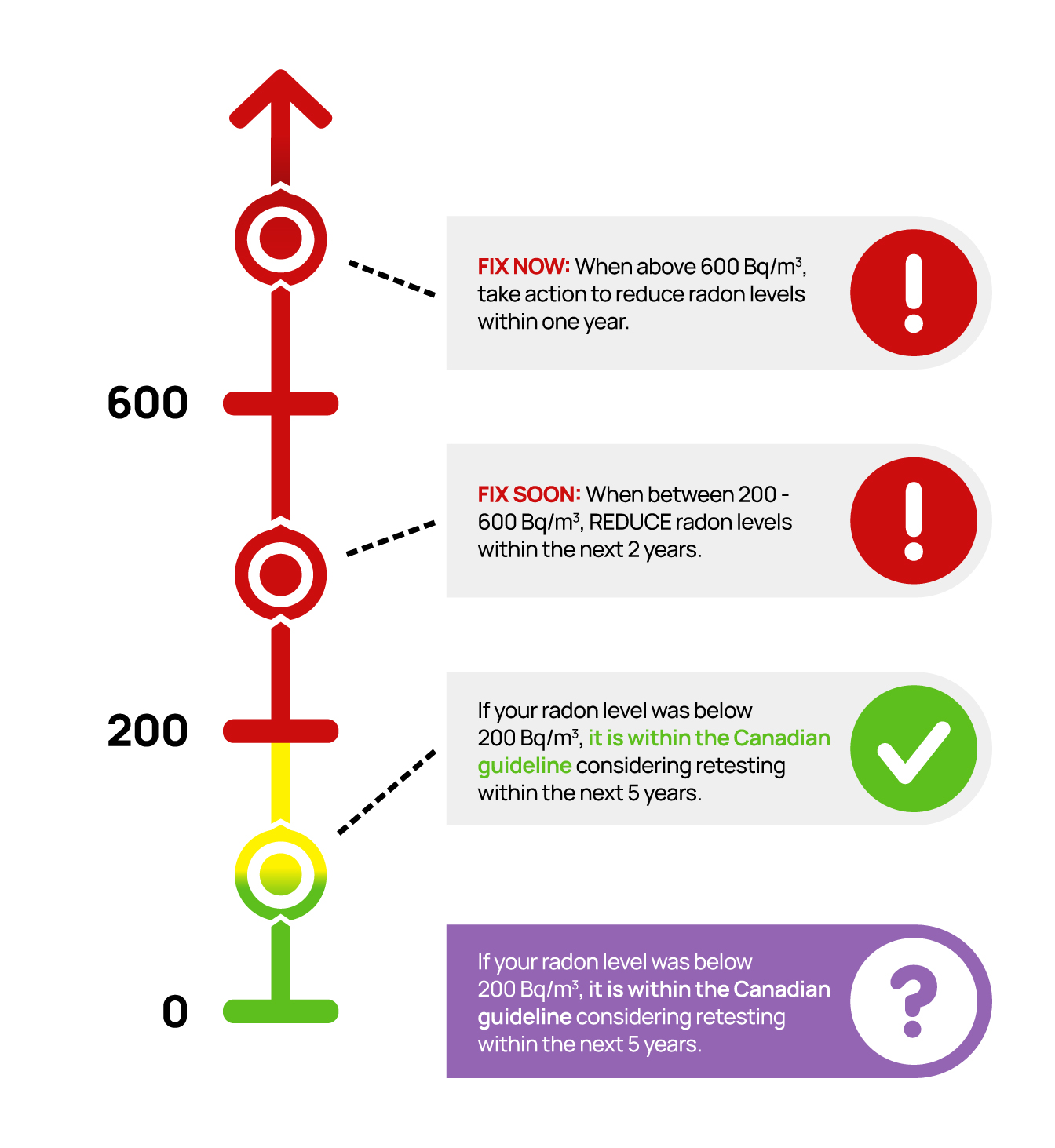Radon Test Results

Table of Contents
Background
Radon is a colorless, odorless, radioactive gas that exists across the planet. It poses a danger if present in high concentrations.
Radon seeps out of the ground into your home through cracks in the foundation/basement slab or around piping. Since it is heavier than air, it will accumulate in the lowest areas of your home.
Breathing high concentrations of radon can contribute to lung cancer.
There are kits to test whether radon exists in your home. I participated in the free testing program, but you can also purchase a Test Kit for approximately $50 - $60.
Remediation, if concentrations over the recommended limits are detected, consists of creating a negative pressure under the basement slab and venting the air outside the house.
The Canadian Lung Association has a good informational web page.
My Test Results
Process
I read about the "100 Radon Test Kit Challenge" in the local paper. It is a Health Canada sponsored program to distribute 100 test kits in Kelowna/West Kelowna/WFN for free. The local program was coordinated by the RDCO.
The "100 Radon Test Kit Challenge" website is here. The website has a lot of information about radon. I found a summary of previous test results from 2021 very informative.
I picked up a test kit at the WFN Health Center and set it up in my basement office in October, 2023. It's a little plastic device (50 x 50 x 8 mm) (see below) that they instruct you to hang in a room that you spend a significant amount of time during the day.

When I opened the kit, the instructions provided a link to a website that explained where to set up the device and how the testing process works. There was a survey to complete prior to beginning the test.
The testing device is left in place for 90 - 100 days.
At the end of the period (February 22, 2024), I turned the device into the WFN office and they sent it to the lab. I then completed the Post-Test Survey.
Lab Report
The Health Canada radon safety standards are shown below.

The radon test program has been running in our community since 2020. These are the 2023 Study Result summaries for West Kelowna and WFN.
I received my Lab Report in the mail a month after turning the device in. The test device recorded a concentration level of 283 ±38 Bq/m³ (becquerels per cubic metre).
That places my home in the "Fix Soon" category to reduce the radon levels below 200 Bq/m³ within 2 years.
Managing Risk
If you've looked at the 2023 Study Result summary reports, over 40% of homes in West Kelowna are above the recommended safe level. Unfortunately, I've not found detailed information that correlate the number of homes to specific measurement levels.
Therefore, I take those two reports with a grain of salt. They do not disclose the number, or percentages, of homes that are >600 Bq/m³. The sample size (1-2%) is quite low and there isn't specific information on neighborhood locations which were tested. The summaries, as they are structured, do not provide useful information to draw concrete conclusions about the degree of risk in our communities.
My home was constructed to R-2000 Standards. The energy efficiency standards at that time (1995-2000) included construction with six inch exterior walls and creating an airtight building envelope. The airtight standards of our homes increase the radon risk, particularly in the winter when windows are unlikely to be open (that's why they test over the winter).
Those of us with basements have the potential for increased risk since there is a larger surface area exposed to permit seepage from the ground. Also, since radon is heavier than air, it will accumulate in lower areas of the home.
My home measured slightly over the safe level. There are a lot of variables which affect the radon levels in your home, such as, the permeability of the earth, whether your basement walls and slabs have cracks, or the sealing of pipes through the cement.
You will have to determine your own risk tolerance and whether you want to perform a radon test and remediation activities.
Future Testing
I was fortunate to read about the program in the paper and apply in time.
I recommend applying for the next "100 Radon Test Kit Challenge" and performing a test on your property; I suspect there will be another program launched in the late summer of 2024. The time and effort required is minimal and, since it is free, there is nothing to lose.
If you miss out on applying for the free test kits, or want to determine the risk in your home, you can purchase the test device for approximately $50 plus return shipping. The price includes processing by the lab. The Canadian Lung Association sells an alternative radon test device or other air quality monitors.
Remediation
Current building codes in most jurisdictions include, at minimum, rough-ins for radon mitigation. Some jurisdictions may require a functioning radon mitigation system in new construction.
Should you wish to install a radon mitigation system, there are certified contractors. There is also a grant program to defray up to $1500 of the cost of mitigation.
This spring, my son did a DIY installation of a system in his older home for approximately $300. The majority of the cost was for the fan itself. The grants are not applicable to DIY installations because additional certified tests (smoke test, flow tests, etc.) must be performed by a certified contractor to qualify for the grant.
This article is solely for informational purposes and is not intended as advice.
Gary Bozek
